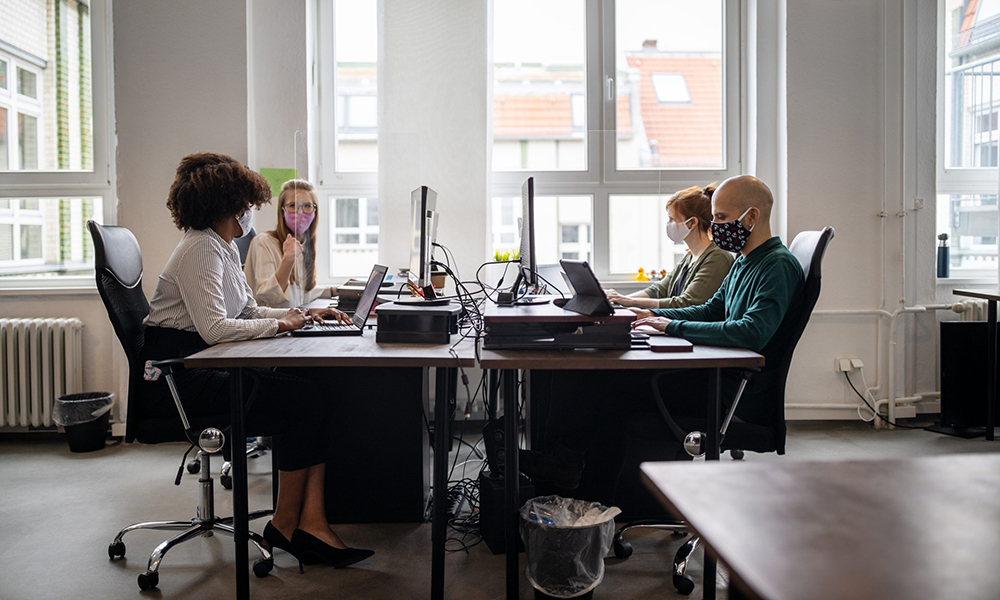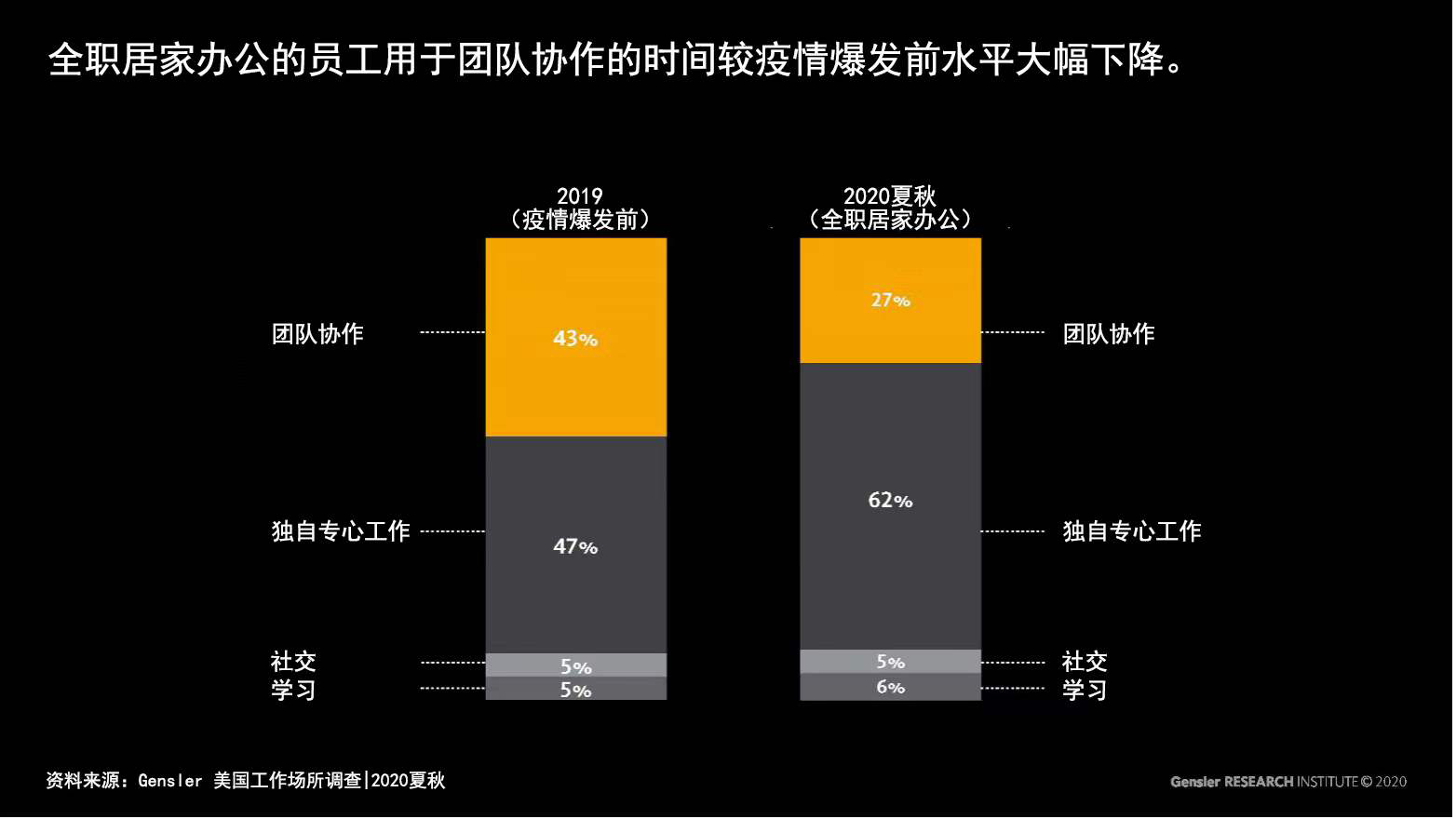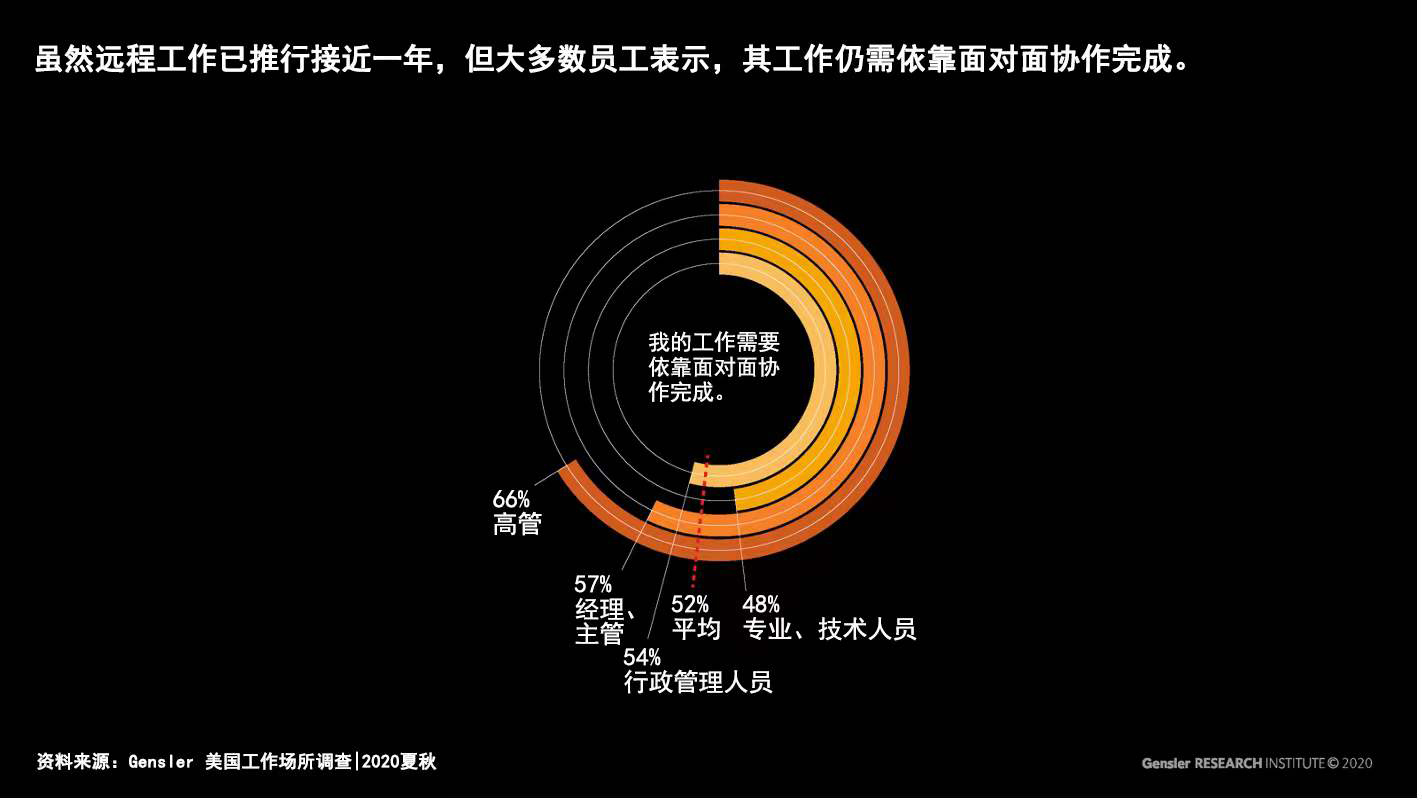
在新冠疫情期间,许多人被迫离开了自己每天办公的工作场所,转为居家办公,我们也迅速适应了这种不断变化的环境。相较过往,现在的工作场所已经有了明显的变化,而这种突如其来的转变也给了我们对线上办公的有效性进行大规模测试的机会。
Gensler最近的一项研究发现,由于新冠疫情期间陡然转向居家办公,团队协作因此遭受了重大冲击。自2019年至2020年,团队协作水平大幅下降,这一现象表明,纯粹的线上工作环境可能会(对团队协作)产生极大的负面影响。这项新发现无疑给那些正在制定返岗办公方案的企业敲响了警钟。(Gensler是一家设计及建筑公司,负责为客户提供工作环境方面的建议,包括返岗办公相关事宜。)
Gensler对工作场所需求及行为的追踪已经持续超过15年,并在2020年进行了多项研究,为市场提供了许多疫情前及疫情期间的相关数据。在新冠疫情爆发前,美国职员平均每周有43%的工作时间用于线上或线下协作,而在2020年居家办公的职员群体中,这一数字下降到了27%的水平。
这意味着,相较新冠疫情爆发前,全职居家工作的员工用于团队协作的时间下降了37%。

通过上述发现可以看出,居家办公已经打破了企业的既有平衡。通常情况下,顶尖公司的优秀员工花在独自专心工作和团队协作上的时间大致相同——各占45%,剩余10%的时间则用于学习和社交。正是由于员工在独自专心工作和团队协作两方面投入的时间大致相当,企业才得以获得当今市场动态组织所需具备的速度和灵活性。
而封城期间的数据则大不相同。新冠疫情期间,居家办公的员工将大约62%的时间花在了独自专心工作之上,而用于团队协作的时间则降低为27%,这种变化对公司的创造力和生产力都产生了负面影响。
研究人员对协作重要性的衡量和记录已经持续了数十年。正如2014年德勤(Deloitte)关于协作经济的一篇报告所总结的那样,协作的商业价值能够从六个关键领域来衡量和定义:速度、工作质量、创新与新想法、员工敬业度、增长和盈利能力。团队协作可以帮助企业提升在上述所有领域的表现。

那么全新的工作模式应该是什么样的呢?
许多“混合解决方案”建议对工作日进行划分,部分工作日“居家办公”,其余工作日“在办公室办公”,但事情可能并非那么简单。对大多数员工而言,无论是独自专心工作还是团队协作,其工作内容中均有正式与非正式、计划内与计划外的部分,而且不同类型工作的比重随时可能发生变化,每一天的工作内容可能也都各不相同。正常情况下,要想完成工作,必须进行有计划的非正式接触,而“混合工作模式”对工作日的简单划分显然无法满足这方面的需求。我们建议在正式施行混合工作模式之前,先对其进行完善、研究和测试,使之获得良好的平衡。
通过打造设计均衡的工作模式、为团队协作和独自专心工作提供支持,组织的整体能力和竞争优势都能获得提升。如果以这种方式重构工作场所,那么协作经济就将有望实现较新冠疫情前基准水平更高的创新和增长。(财富中文网)
黛安娜·霍斯金斯是Gensler的联席首席执行官
译者:梁宇
审校:夏林
在新冠疫情期间,许多人被迫离开了自己每天办公的工作场所,转为居家办公,我们也迅速适应了这种不断变化的环境。相较过往,现在的工作场所已经有了明显的变化,而这种突如其来的转变也给了我们对线上办公的有效性进行大规模测试的机会。
Gensler最近的一项研究发现,由于新冠疫情期间陡然转向居家办公,团队协作因此遭受了重大冲击。自2019年至2020年,团队协作水平大幅下降,这一现象表明,纯粹的线上工作环境可能会(对团队协作)产生极大的负面影响。这项新发现无疑给那些正在制定返岗办公方案的企业敲响了警钟。(Gensler是一家设计及建筑公司,负责为客户提供工作环境方面的建议,包括返岗办公相关事宜。)
Gensler对工作场所需求及行为的追踪已经持续超过15年,并在2020年进行了多项研究,为市场提供了许多疫情前及疫情期间的相关数据。在新冠疫情爆发前,美国职员平均每周有43%的工作时间用于线上或线下协作,而在2020年居家办公的职员群体中,这一数字下降到了27%的水平。
这意味着,相较新冠疫情爆发前,全职居家工作的员工用于团队协作的时间下降了37%。
通过上述发现可以看出,居家办公已经打破了企业的既有平衡。通常情况下,顶尖公司的优秀员工花在独自专心工作和团队协作上的时间大致相同——各占45%,剩余10%的时间则用于学习和社交。正是由于员工在独自专心工作和团队协作两方面投入的时间大致相当,企业才得以获得当今市场动态组织所需具备的速度和灵活性。
而封城期间的数据则大不相同。新冠疫情期间,居家办公的员工将大约62%的时间花在了独自专心工作之上,而用于团队协作的时间则降低为27%,这种变化对公司的创造力和生产力都产生了负面影响。
研究人员对协作重要性的衡量和记录已经持续了数十年。正如2014年德勤(Deloitte)关于协作经济的一篇报告所总结的那样,协作的商业价值能够从六个关键领域来衡量和定义:速度、工作质量、创新与新想法、员工敬业度、增长和盈利能力。团队协作可以帮助企业提升在上述所有领域的表现。
那么全新的工作模式应该是什么样的呢?
许多“混合解决方案”建议对工作日进行划分,部分工作日“居家办公”,其余工作日“在办公室办公”,但事情可能并非那么简单。对大多数员工而言,无论是独自专心工作还是团队协作,其工作内容中均有正式与非正式、计划内与计划外的部分,而且不同类型工作的比重随时可能发生变化,每一天的工作内容可能也都各不相同。正常情况下,要想完成工作,必须进行有计划的非正式接触,而“混合工作模式”对工作日的简单划分显然无法满足这方面的需求。我们建议在正式施行混合工作模式之前,先对其进行完善、研究和测试,使之获得良好的平衡。
通过打造设计均衡的工作模式、为团队协作和独自专心工作提供支持,组织的整体能力和竞争优势都能获得提升。如果以这种方式重构工作场所,那么协作经济就将有望实现较新冠疫情前基准水平更高的创新和增长。(财富中文网)
黛安娜·霍斯金斯是Gensler的联席首席执行官
译者:梁宇
审校:夏林
When the pandemic forced most of us to relocate from our traditional work environments to makeshift home offices, we quickly adapted to make the best of a constantly changing situation. The workplace had been evolving already, but this abrupt shift provided us with the opportunity to test the virtual office environment's effectiveness on a large scale.
According to recent Gensler research, the dramatic shift toward work from home during the pandemic has dealt a significant blow to collaboration. The startling decline in collaboration from 2019 to 2020 signals that there could be considerable downside to working environments that are entirely virtual. This new finding offers warning signs for businesses that are in the process of planning how they will return to the office. (As a design and architecture firm, Gensler advises clients on work environments, including returning to physical offices.)
Gensler has tracked workplace needs and behaviors for over 15 years—including multiple studies conducted in 2020 that provide data from both before and during the COVID crisis. Before the pandemic, U.S. workers spent an average of 43% of their workweeks collaborating either virtually or in person. That number fell to 27% for workers who worked from home in 2020.
This means that people working full-time at home spent 37% less time collaborating than before the pandemic.
These findings reveal how working from home has thrown businesses out of balance. Typically, high-performing people at top companies tend to do individual work and collaborative work in equal measures—45% each, according to our research, with the remaining 10% made up of learning and social time. This near-equal proportion of individual and collaborative work meets the speed and agility required for dynamic organizations in today’s marketplace.
During the quarantine, the numbers were far different. While at home during the pandemic, people reported working in individual focus mode 62% of the time and 27% in collaboration, a disparity that negatively impacts company creativity and productivity.
Researchers have measured and documented the importance of collaboration for several decades. As summarized in a 2014 Deloitte report on the collaborative economy, the business benefits of collaboration can be measured and defined in six critical areas: speed, quality of work, innovation and new ideas, employee engagement, growth, and profitability. Collaborative work-styles increase all of these factors.
So what should the new workplace model look like?
Many hybrid solutions suggest a mix of in-office and at-home days during the week, but it may not be that simple. Focus work and collaboration for most people are both formal and informal, scheduled and unscheduled. These modes can vary by the hour throughout the day, and the mix can be different each day of the week. Hybrid models with workdays assigned as being entirely composed of either collaboration or focus do not support the normal cycle of planned and informal interactions necessary to get work done. We recommend crafting, studying, and testing hybrid strategies before implementation to achieve the right balance.
A balanced design that supports both collaboration and focus can expand an organization’s capabilities and competitive advantage. As we rethink our workplaces in this way, the collaboration economy could be on track to achieve levels of innovation and growth beyond pre-COVID benchmarks.
Diane Hoskins is co-CEO of Gensler.






